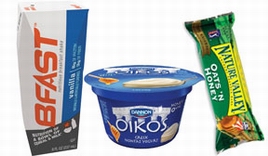 While the agribusiness research firm Rabobank is not predicting the demise of the $10 billion U.S. breakfast cereal category, the firm does see significant challenges ahead for cereal makers, including increased competition and demographic shifts. Rabobank outlined the challenges facing the breakfast cereal category in a new report titled “The cereal killers: Five trends revolutionizing the American breakfast.”
While the agribusiness research firm Rabobank is not predicting the demise of the $10 billion U.S. breakfast cereal category, the firm does see significant challenges ahead for cereal makers, including increased competition and demographic shifts. Rabobank outlined the challenges facing the breakfast cereal category in a new report titled “The cereal killers: Five trends revolutionizing the American breakfast.”“Is breakfast cereal, an American staple once characterized by strong innovation and competitive brand marketing, failing to meet the challenges of the 21st century consumer landscape?” asked Nicholas Fereday, global senior analyst with Rabobank’s Food & Agribusiness Research and Advisory group. “Flat sales and declining volumes over the past decade indicate consumers are tiring of boxed cereals, lured away by more contemporary, aspirational, and convenient morning eating options in other grocery aisles or restaurants.”
The five trends highlighted in the report include breakfast as an eating occasion away-from-home. Breakfast is fast becoming a day-part of fierce competition in the quick-service restaurant space, and chains such as the Starbucks Coffee Co. and Dunkin’ Brands, Inc., have sought to establish a strong foothold in the category with the introduction of new menu items.
The breakfast occasion also is becoming inundated with snacks intended to be a part of the morning meal. Snack products may include longtime staples such as nutrition bars as well as newer products such as breakfast beverages like Bfast from General Mills, Inc. and Kellogg To Go from the Kellogg Co.
Greek yogurt also has secured a seat at the breakfast table, according to Rabobank. Consumers relate protein to satiety and weight management, and yogurt is considered a convenient, portable option for adding protein to the diet.
Criticism from consumer groups and regulatory officials also may be taking a toll on the breakfast cereal category, Rabobank said. Two hot button issues today are added sugars and marketing food to children, both subjects that have had an effect on cereal makers.
Finally, the slowing birth rate in the United States was identified by Rabobank as an issue. Children are a key consumer of breakfast cereals and with fewer of them companies are challenged to attract other demographics such as millennials or baby boomers.
“Despite the numerous health positives associated with breakfast cereal, some companies already appear to be exiting through the snack aisle,” Mr. Fereday said. “We are not predicting the end of this $10 billion market; rather, we believe that breakfast cereals can aspire to more than single-digit growth and erosion of market share. To turn the tide, we suggest a renewed focus on innovation, a rebooting of the message to consumers, and, for children’s cereal, an embrace of what you are, even if that means new positioning in a different grocery aisle.”
Innovation strategies highlighted by Rabobank include bigger, better bets to generate new brand platforms, such as what the Kraft Foods Group has done with MiO, Oscar Mayer Selects and Velveeta Skillets. Another option may be spending more on food ingredients relative to advertising budgets and learning from the success of companies like Clif Bar & Co., Chipotle Mexican Grill and Whole Foods.
Finally, Rabobank said the breakfast cereal category pioneered marketing in the age of mass media, but is struggling to find its voice and target customers in today’s age of multimedia and fragmented retail channels. In addition, some current consumer food trends do not necessarily play well to cereal’s core strengths, as some consumers are moving away from food perceived as highly processed. Nevertheless, Rabobank said the breakfast cereal category remains a relevant platform for delivering many health and wellness positives, but manufacturers need to reboot their message to consumers regarding the relevance of the product.





